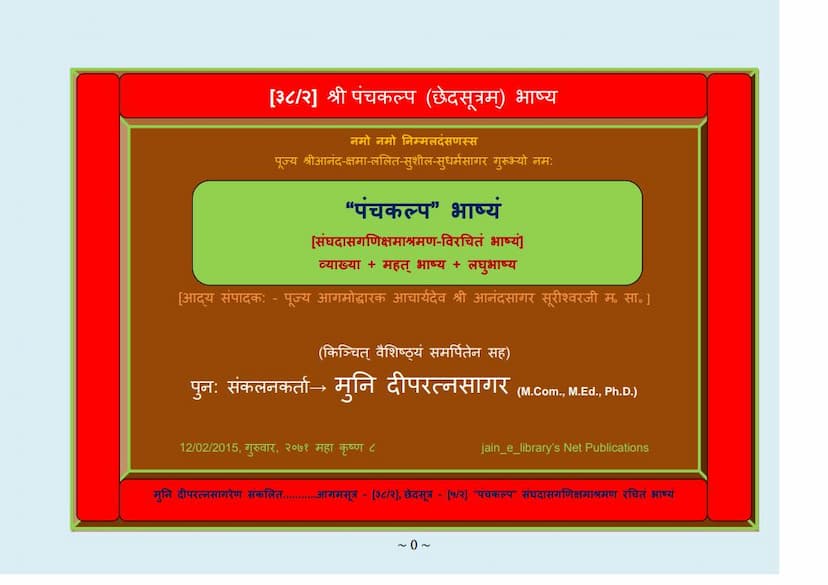Aagam 38 B PANCHKALP Bhashya Ev
Added to library: September 1, 2025

Summary
This comprehensive summary is based on the provided Jain text, primarily the "Panchkalp Bhashya" (Agam 38 B), authored by Dipratnasagar and Deepratnasagar, and published by Deepratnasagar. The catalog link provided is https://jainqq.org/explore/004139/.
Title: Panchkalp Bhashya (Agam 38 B) Original Author: Sanghadās Gaṇi Kṣamāśramaṇa Compiler/Re-compiler: Muni Deepratnasagar (M.Com., M.Ed., Ph.D.) Editor/Reviser: Ācārya Śrī Ānandsāgar Sūriśvarjī (also known as Sāgarānandsūri) Publisher: Deepratnasagar Publication Date (as per metadata): 12/02/2015, Thursday, 2071 Maha Krishna 8
Overall Summary:
The "Panchkalp Bhashya" is a significant Jain text, a commentary (Bhashya) on the "Panchkalp" Chhedasutra, attributed to Sanghadās Gaṇi Kṣamāśramaṇa. This particular publication, compiled and re-edited by Muni Deepratnasagar under the guidance of Acharya Anand Sagar Surishwarji, aims to make this ancient text accessible in a modern format, including digital publication. The text delves into various aspects of Jain monastic conduct, rules, and philosophical principles, providing detailed explanations and classifications.
Key Aspects and Content:
The text is structured into various sections, indicated by "Bhashyank" (commentary index number) and "Vishay" (subject). The table of contents reveals a wide range of topics discussed, including:
- Introduction and Salutations: The text begins with salutations to the lineage of Gurus and the author.
- Foundational Jain Concepts:
- Vandana to Bhadrabahu: Acknowledging the importance of ancient acharyas.
- Charitra (Conduct) and its Divisions: Elaborating on the various aspects and classifications of Jain ascetic conduct.
- Qualities of an Ideal Acharya: Describing the characteristics and virtues of a spiritual preceptor.
- Consequences of the Dushamkal (Adversity Period): Discussing the impact of challenging times on spiritual practice.
- Eligibility and Exclusion for Monastic Life:
- Ineligible Individuals for Initiation: Detailing those who are not suitable for the monastic path due to various reasons, including physical ailments, mental deficiencies, or past negative karma.
- Monastic Rules and Practices:
- Viharyogya Kṣetrāṇām Guṇāḥ (Qualities of Suitable Areas for Travel): Discussing the appropriate places and conditions for monks to travel.
- Upadhi (Possessions) and its Regulations: Detailing the permitted and prohibited possessions for ascetics, including discussions on various types of "kalpas" (rules or observances related to possessions).
- Specific Kalpas: The text enumerates various "kalpas" such as:
- Nama-sthāpanādi 20 Kalpas: Rules related to names, establishment, etc.
- Dravya-Bhavaādi 20 Kalpas: Rules concerning material and spiritual aspects.
- Dravya-Bhāvādi 42 Kalpa-bhedas: Further detailed classifications of kalpas.
- Ling-upadhi-sambhog Kalpas: Rules pertaining to symbols, possessions, and sharing.
- Sūtra-kalpa, Uddeśa-kalpa, Vacanāyāḥ Guṇāḥ: Rules related to scriptures, teachings, and their qualities.
- Fasting and Dietary Rules: Discussion on "Masakalpa" (monthly observance), "Paryushana" (period of fasting and austerity), "Vriddhavas" (staying with elders), and rules related to food ("lokpinda," "bhojanvidhi," "pūti").
- Kaayotsarga and other practices: Mentioning practices like "Kaayotsarga" (standing meditation), "Pratikramaṇa" (repentance), "Kritikarma" (ritualistic duties), and "Pratīlekhanā" (sweeping the path).
- Detailed Classifications of Kalpas: The text meticulously categorizes and explains numerous "kalpas," ranging from 20, 42, and even 10 types in different contexts, covering aspects of possessions, conduct, and rituals.
- Philosophical Underpinnings: The Bhashya likely elaborates on the underlying philosophy and rationale behind these strict monastic rules, emphasizing purity of conduct and liberation.
- Specific Sections Highlighted (from the index):
- Dīkṣādāne Ayogyāḥ (Ineligible for Initiation): A significant portion likely details reasons for disqualification.
- Pravrajyā: 16 Bhedāḥ (16 Types of Renunciation): Providing detailed examples of different forms of taking up monastic life.
- Upadhī-jin-Sthavira Kalpa: Rules related to possessions and the traditions of Jinism and Sthaviras.
- Vihārayogya Kṣetrāṇām Guṇāḥ (Qualities of Areas Suitable for Travel): Essential for itinerant monks.
- Ānāyatana (Unsuitable Places): Identifying places unsuitable for spiritual practice.
- Upasthāpanā Vidhi: Procedures for establishing or venerating something.
- Ling-upadhi-sambhog Kalpas: Rules concerning symbols, possessions, and sharing.
- Dravya-Bhāvādi 42 Kalpa-bhedas: Further classifications of rules.
Methodology and Presentation:
Muni Deepratnasagar highlights his efforts in making this text accessible. He mentions that this publication is based on the text that was inscribed on stone slabs at Shatrunjay Tirth and on copper plates in Surat, derived from the "Āgam Manjushā" project initiated by Acharya Anand Sagar Surishwarji in 1942. The current effort involves scanning and digitizing these texts to reach a wider audience through internet publications and DVDs. The compilation aims to preserve the original layout and content as much as possible, with clear referencing to the sequence of verses and the compiler's own index ('Deep Anukram') for easy navigation across different Jain Agam publications.
Significance:
The "Panchkalp Bhashya" is crucial for understanding the intricacies of Jain monastic discipline and the rigorous path to liberation. It provides a detailed framework for ascetics to maintain purity of conduct, thought, and action, which are central to the Jain spiritual journey. The effort to digitize and disseminate this text ensures its preservation and availability for future generations of scholars and practitioners.